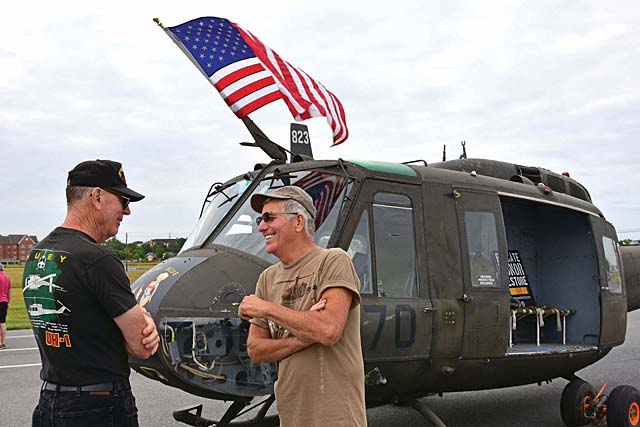 |
||||||||||||
|
March/April 2017
BY XANDE ANDERER I traveled to the Lancaster Airport in Pennsylvania’s Amish country to meet a hero: a bone-weary warrior with a frame ravaged equally by age as by war, a faithful soldier who witnessed firsthand the foreboding lulls and rattling crescendos of human conflict. I came to meet a two-tour Vietnam veteran who is vying for a second career as both teacher and counselor. A new job teaching future generations those very things witnessed almost fifty years ago, while at the same time helping fellow vets to spill their guts in a way they couldn’t to anyone else. Her name: 66-16823 Inside the Dutch Country Helicopters hangar at the Lancaster Airport, the dedicated men and women of the Liberty War Bird Association are in the midst of an ambitious restoration of this Bell UH-1H—known as “Huey 823” for short—back to flying condition. The helicopter logged 1,300 hours in Vietnam between 1968 and 1970 with the 170th Assault Helicopter Co., a.k.a. The Bikinis (and later with the Black Widows of the 101st Aviation Bn.)
The slicks of the 170th sported distinctive pinup-and-dragon nose art courtesy of an artistic chief warrant officer, Russ Mowry, who hand-painted a shapely blonde beachgoer on each Huey’s avionics bay. When Mowry—now living in New Hampshire—heard about Liberty War Bird Association’s restoration effort, it took little persuasion to get him to recreate that same nose art on 823 during Army Heritage Days last May. He later realized he had actually flown her in Vietnam.
The tailboom—which needed to be replaced due to an unanticipated safety issue—is in place, freshly repainted and re-stenciled. And two brand new main fuel cells are now aboard. The group, however, still has significant hurdles to overcome before she’ll be flying in air shows, veteran flights, holiday observances, community days, and sporting events. VVA life member Jim Haga serves as the Liberty War Bird Association president. A two-tour pilot with the 155th Assault Helicopter Company at Ban Me Thout, Haga is a flight instructor at Dutch Country Helicopters. “We have rotor blades and an engine deal in the works, but without cash on hand, we can’t close those deals,” Haga explained. “We’re really at the mercy of donations to get this done.” Main rotor blades have proven to be the organization’s most difficult challenge. The ship’s set of donated rotor blades, which the group had received with paperwork showing more than 1,500 flight hours of life remaining, failed FAA safety inspection and are beyond repair. Used rotor blades can cost upward of $40,000, even with just a few hundred hours left on them.
If the donations keep coming, the group plans to have Huey 823 in the air later this year. When finished, she will be one of only a handful of restored and operational Vietnam-era UH-1s in the air, and the only one flying in the Northeast. Lately there has been a trend toward static Hueys on display at memorials, but Haga understands this one can do much more as a flying museum. “Our motto for Huey 823 is ‘Educate, Honor, and Restore.’ ” he explained. “We plan to take her to airshows and patriotic events to educate the public about all the ways Huey helicopters and their crews served the grunts. And the passionate, courageous, and creative ways they went about that mission.” The group hopes that by providing rides to the general public and ‘re-experience rides’ for veterans, they can initiate meaningful conversations across generations. The association has even begun to collect stories for posterity through an affiliated oral history project. “We also hope to take the helicopter on honor flights to VA centers. Maybe even to deliver Thanksgiving dinner much as it was delivered in-country,” Haga said. “We will support veterans organizations any way we can—especially those that have supported us so well.”
Even in its current unfinished state, Huey 823 is starting to create a stir. Local residents have heard rumors there is a Huey in the hangar and have started to drop in during the restoration. “We see veterans come in, maybe touch the aircraft or maybe stand away from her for a few minutes.” said Oral History Project Manager Alexis Lake. “We can see the emotions flicker across their faces.” There is perhaps no greater bond between warriors and their war machines than the one between Vietnam veterans and the Huey. Sure, fighter jocks bond with their particular brand of fighter, and tank crews feel the machine they wielded is unrivaled. But this type of bond is unique because it is one not just between machine and operator; it’s between a machine and the entire force it served.
“The Huey was so important to the troops in Vietnam that it has become a touchstone—a common element that all Vietnam veterans share. As that touchstone, when vets see, hear, or touch Huey 823, it can be an emotional event,” Haga explained. “We know from what we have already seen that she is a powerful healing force for Vietnam vets. Just sitting in the hangar, she has brought closure to many of them. Imagine how many we can help when we can fly to them, and they can fly with us for one more mission.” For this reason the organization has pledged to have a qualified PTSD counselor on-site for all events. “Many of our volunteers have had the opportunity to listen to stories of long-buried trauma. While it is often difficult, it is a cathartic experience,” Haga said. “Sometimes it’s tears. Sometimes it’s quiet reverence. “They often say it’s the first time they ever told anybody that story.”
|
||||||||||||
|
|
||||||||||||
|
||||||||||||
8719 Colesville Road, Suite 100, Silver Spring. MD 20910 | www.vva.org | contact us |
||||||||||||





















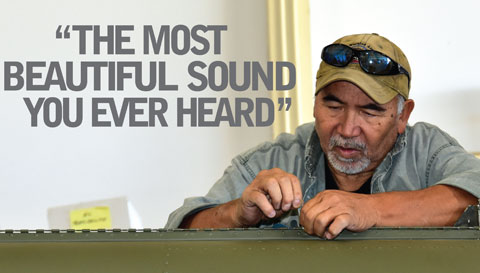
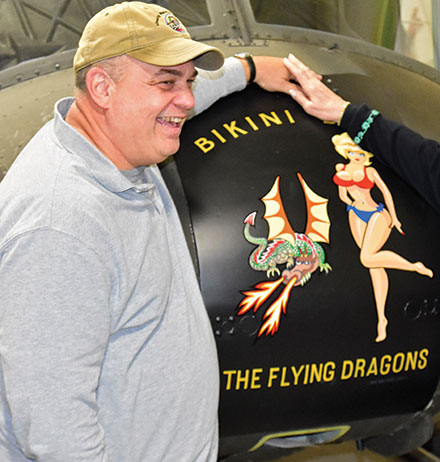 The 170th arrived in Pleiku in December 1965 and operated from there until 1970 when they moved just north to Kontum, earning two Presidential Unit Citations, a Valorous Unit Award, five Vietnam Crosses of Gallantry, and the Civic Action Honor Medal. Fifty-seven Bikinis lost their lives while in-country, and Huey 823 shows plenty of evidence of their dangerous missions. Countless bullet-hole patches riddle her frame, especially her engine cowling.
The 170th arrived in Pleiku in December 1965 and operated from there until 1970 when they moved just north to Kontum, earning two Presidential Unit Citations, a Valorous Unit Award, five Vietnam Crosses of Gallantry, and the Civic Action Honor Medal. Fifty-seven Bikinis lost their lives while in-country, and Huey 823 shows plenty of evidence of their dangerous missions. Countless bullet-hole patches riddle her frame, especially her engine cowling.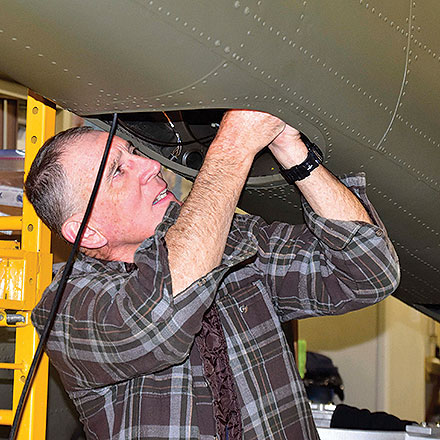 Liberty War Bird Association, a 501(c)(3) nonprofit, is about halfway to its fundraising target of $475,000. Much has already been accomplished since acquiring the Huey from a private owner in Fresno, California, in April of 2015. The instrument panel has been disassembled, painted, rewired, and reassembled. The cockpit has been restored to its original Vietnam-era gray and its armor-plated seats refurbished.
Liberty War Bird Association, a 501(c)(3) nonprofit, is about halfway to its fundraising target of $475,000. Much has already been accomplished since acquiring the Huey from a private owner in Fresno, California, in April of 2015. The instrument panel has been disassembled, painted, rewired, and reassembled. The cockpit has been restored to its original Vietnam-era gray and its armor-plated seats refurbished. 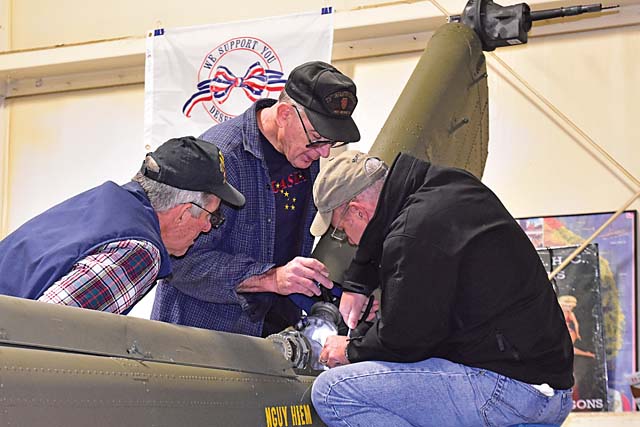
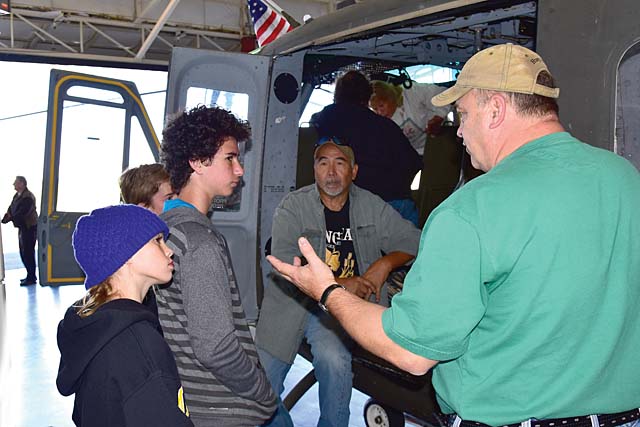
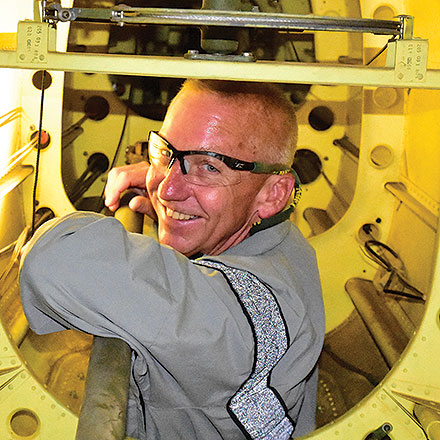 Hueys touched just about everyone’s lives in Vietnam. They didn’t merely transport troops to and from the battlefield. They provided covering fire from above and rescued men from harm. They brought the mail from home and delivered food and supplies to those cut off in the field. To troops in the shit, that distinctive thump-thump-thump truly was “the most beautiful sound you ever heard.”
Hueys touched just about everyone’s lives in Vietnam. They didn’t merely transport troops to and from the battlefield. They provided covering fire from above and rescued men from harm. They brought the mail from home and delivered food and supplies to those cut off in the field. To troops in the shit, that distinctive thump-thump-thump truly was “the most beautiful sound you ever heard.”